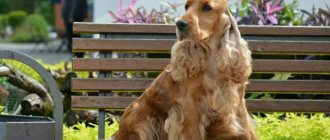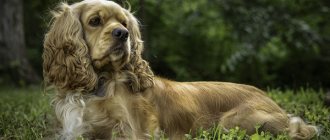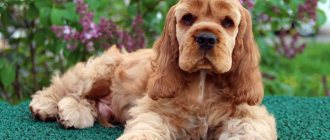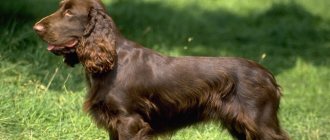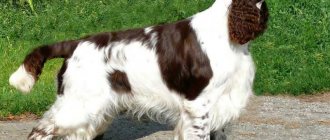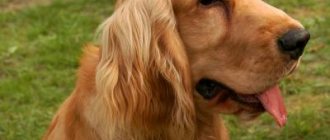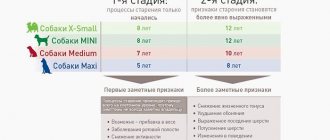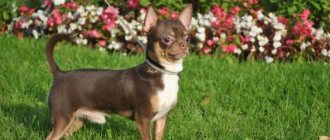Origin story
The famous Caesar himself first brought dogs to England, and there everything went as usual - the inhabitants of the country made a great contribution to their development. These animals appeared a long time ago, and at first they helped hunt birds.
At first, there were only field and marsh dogs - they hunted both birds and helped catch game with nets. Then a universal representative appeared - long-haired , he, as you might guess, was distinguished by very long hair. This happened four centuries ago - can you imagine how deep the roots go?
Somewhat later they were divided into large ones - Fields and small ones - Cockers. The ancestor of all is considered to be the black male Obo, who lived in England at the end of the seventeenth century. American cockers descended from his son, Obo the Second. They came to Russia only in the twentieth century.
Brief history of the breed
The exact origins of the English Cocker Spaniel breed are unknown. The animals are believed to be descended from Spanish longhaired hunting dogs or British "agassos". Cynologists began to actively breed the breed only in the 19th century. In 1885, experts, in order to promote the official recognition of dogs, formed the English Spaniel Club. The efforts of cocker spaniel lovers were not in vain: in 1893 the breed was officially registered. The International FCI Standard was formulated in 1974.
This is interesting! The name of the breed “Cocker Spaniel” comes from the English phrase “span spaniel”, which literally conveys the main characteristic of the dog “one who jumps high”, and “cocker”, that is, “woodcock” (a bird that dogs hunted).
Description of the breed
The official standard appeared in 1902, since then many changes and adjustments have been made to it. The features are:
- smooth outlines of the skull, which looks elegant,
- large nose, giving a keen sense of smell ,
- the eyes are large, but they are not convex,
- eyes come in different shades of brown - light and dark,
- the ears are located at eye level, their length is up to the tip of the nose, hanging,
- the jaws are strong, there is a scissor bite,
- strong and short neck,
- deep developed chest,
- powerful loin, not very long, straight at the top, gently sloping towards the tail,
- movable tail below back level . When moving it does not ride up. If the dog is used for hunting, the tail is docked,
- the paws are muscular and strong, have dense pads,
- coat without curls, straight, silky and shiny,
- the hair on the head is short, the hair on the ears, chest and belly is long,
- the color can be solid or spotted. Newborn puppies have whitish spots on the face or paws, which later become invisible. Representatives of the same color may have tan or transition.
American Cocker Spaniel
Origin : USA.
Date of publication of the original current standard : 05/17/1993
Use : Gun dog, companion dog.
Fci classification : Group 8. Retrievers, gun dogs, water dogs. Section 2. Gun dogs. Without testing of working qualities.
Brief historical summary The American Cocker Spaniel is the smallest representative of the sporting gundog (hunting) group of dogs. He has a strong, compact body, a beautifully contoured, graceful head of ideal size that harmoniously fits into the overall silhouette of the dog. Stands steadily on straight front legs, with emphasis on the shoulders. The topline slopes gently back towards the moderately arched, muscular hindquarters. This dog is capable of developing significant speed combined with great endurance. First of all, the cocker must be graceful and cheerful, strong, harmoniously built and demonstrate a great desire to work. A dog that is harmonious in all respects is preferable to an individual with pronounced advantages and disadvantages. Important Proportions The length of the body, measured from the sternum to the ischial tuberosity, is slightly greater than the height of the dog at the withers. The body should be of sufficient length to allow the dog to move straight and freely, but the dog should never appear long or squat. Behavior/character Balanced, without signs of timidity. Head Proportional and harmonious to the overall build of the dog. With an intelligent, attentive, soft and touching expression in the eyes.
- Skull part:
- Skull: Rounded but not excessively rounded; not flat, with a noticeable infraorbital region; the brow ridges are well defined.
- Stop: Expressed.
- Nose: Of sufficient size to be in harmony with the muzzle and front of the head, with well developed nostrils typical of a hunting dog. The nose is black in dogs of black, black and tan and black and white colors. In other colors the nose can be brown, liver or black, the darker the better. The color of the nose corresponds to the color of the rim of the eyelids.
- Muzzle: Broad and deep. With the correct proportions, the distance from the stop to the tip of the nose is equal to half the distance from the stop to the occipital protuberance.
- Lips: The upper lip is thick and of sufficient length to completely cover the lower jaw.
- Jaws/teeth: Jaws square and level. The teeth are strong and healthy, not too small, set in a scissor bite.
- Cheekbones: Not prominent.
- Eyes: Eyeballs are round, full and look strictly straight. The cut of the eyelids gives the eyes an almond shape; The eyes are not set deep, but not protruding either. The color of the iris is dark brown; in general, the darker the better.
- Ears: Lobed, long, thin, well-furred, set no higher than the lower line of the eyes.
The neck is quite long, allowing the dog to easily touch the ground with its nose, muscular and without visible dewlap. Rising strictly from the shoulders, well arched and tapering towards the base of the head. Frame
- Topline: Slightly sloping towards the hindquarters.
- Back: Strong, evenly sloping and slightly sloping from the shoulders to the base of the docked tail.
- Chest: Deep; at the lowest point no higher than the elbows; The fore chest is moderately wide to allow sufficient room for the heart and lungs, but not so wide as to interfere with the straight movement of the forelegs. The ribs are deep and well sprung.
Tail The docked tail is set and carried in continuation of the top line or slightly higher; never carries vertically, like a terrier, and should not be tucked in, which would indicate timidity. When the dog moves, it wags its tail cheerfully. LIMBS
- Forelegs:
- General appearance: The forelimbs are parallel, straight, with strong bones, muscular, tightly pressed to the body under the shoulder blades.
- Shoulders: The shoulder blades are well laid back and form an angle of approximately 90° with the humerus bones, which allows the dog to move with good reach of the forelimbs. The shoulder blades are well developed and sloping, tightly fitting. The upper edges of the shoulder blades form the highest point of the withers and are located quite widely, which determines a good bend of the ribs.
- Elbows: When viewed from the side, with the forelegs vertical, the elbows are directly under the highest point of the shoulder blade.
- Pasterns: Short and strong. The dewclaws on the front legs may be removed.
- Hind limbs:
- General appearance: When viewed from behind, the hindquarters are parallel both when moving and when standing. With well-developed bones, muscular.
- Hips: Wide, well rounded and muscular.
- Lower thighs: Strong and well defined.
- Knee joints: With moderate angles. Strong, not loose either in movement or in stance.
- Hocks: Strong and low set. Dewclaws may be removed.
- Feet: Compact, large, rounded, with hard, dense pads. Turned neither in nor out.
Gait/Movement The American Cocker Spaniel, although the smallest of the sporting hunting dogs, has the movements typical of hunting dogs. A prerequisite for good movement is balance between the front and hind limbs. He has a strong and powerful drive from the hindquarters, which are in anatomical agreement with the shoulders and forequarters, so that he moves forward without stiffness, with a long stride corresponding to the drive of the hindquarters. First of all, the movements are coordinated, smooth and easy. A dog in motion must cover considerable distances; Excessive liveliness should not be mistaken for correct movements. COAT Coat: The hair on the head is short and soft; on the body - medium length, with sufficient undercoat to provide protection from bad weather. The ears, chest, belly and legs are well furred, but not so much as to obscure the typical lines and movements of a Cocker Spaniel or to detract from his appearance and function as a moderately furry hunting dog. The most important thing is the texture of the coat. The coat is silky, straight or slightly wavy, and is easy to groom. Excessive hair coat, curly or felt-like coats should be severely punished. Using an electric clipper to trim hair on the back is not advisable. To best show off the dog's lines, trimming should be done, leaving the dog as natural as possible. Color and Markings: Black: Completely black, includes black and tan (black and tan). The black color should be pitch black; shades of brown or liver are highly undesirable. A small amount of white hair on the chest and/or throat is acceptable; in other places - disqualified. Any solid colors other than black: Any other solid colors other than black, from light fawn to dark fawn, including brown and brown and tan. The color must be uniform; Light bleaching on the fringe is permitted. A small amount of white hair on the chest and/or throat is acceptable; in other places - disqualified. Mixed color: Two or more solid, clearly distinguishable colors, one of which must be white; black and white; red and white (red can range from light fawn to dark red); brown and white and roan. Any combination of these colors can be accompanied by tan. It is preferable that the tan spots be located in the same places as in individuals of black and other solid colors. Roan dogs qualify as mixed-color dogs and can consist of any of the regular roan colors. If one of the colors is dominant (90% or more), the dog is disqualified. Tan Patches: The color of tan ranges from light fawn to dark red and is limited to ten percent (10% or less) of the total color area; If this figure is exceeded, the dog is disqualified. In the case of black or other solid color, the markings must be located in the following places:
- A clear spot of sunburn above each eye;
- On both sides of the muzzle and on the cheekbones;
- On the inner sides of the ears;
- On all paws and/or legs;
- Under the tail;
- It may be present or absent on the chest - it is not punishable.
Marks that are not clearly visible or only indicated must be penalized. Marks on the muzzle that extend upward and merge should also be penalized. The absence of tan in individuals of black or any other solid color in the above areas is a disqualifying fault. Dimensions The ideal height at the withers for an adult male is 15 inches (38 cm); for an adult female – 14 inches (35.5 cm). The height at the withers may vary up to half an inch more or less than ideal. Males exceeding 15.5 inches (40 cm) in height at the withers and females exceeding 14.5 inches (37 cm) in height at the withers are subject to disqualification. Adult males under 14.5 inches (36 cm) and females under 13.5 inches (34 cm) must be penalized. The height at the withers is determined by the length of the perpendicular, lowered from the tops of the shoulder blades to the ground, the dog stands naturally, its front legs and metatarsals are parallel to the measurement line. Faults/Defects Any deviation from the above provisions should be considered as a fault/defect and the seriousness with which the fault/defect is assessed should be proportionate to its severity and its effect on the health and welfare of the dog. Disqualifying faults
- Aggression or cowardice.
- Any dog clearly showing physical or behavioral abnormalities must be disqualified.
- Color and markings: Only approved colors and color combinations are acceptable. Any other colors or combinations thereof are disqualified.
- Black: White markings anywhere except chest and throat.
- Any solid color except black: White markings anywhere except chest and throat.
- Mixed colors: Predominance of one color by 90% or more.
- Tan marks: The area of tan marks exceeds 10% of the total color area; The absence of tan spots (if any) in strictly designated areas of its location in black or other solid colors.
- Height: Males over 15.5 inches (39.3 cm), bitches over 14.5 inches (36.8 cm).
SPECIAL ATTENTION:
- Males must have two normally developed testes, fully descended into the scrotum.
- Only functionally and clinically healthy dogs with breed-specific characteristics can be used for breeding.
Dog character
These puppies are very sociable and affectionate , they love to play and be close to their owner. Both single people and those with a large family can get a cocker - the dog will be happy in both cases.
They are very dependent on their owner, which can negatively affect their future maintenance, so it is important to teach them to be independent. This should be done at a very early age.
The dog has some willfulness, which manifests itself in relation to personal things, for example, toys. This is a wonderful hunter, full of energy, with an excellent sense of smell and vision.
If a friend on four legs is purchased for hunting, she will have no equal in finding and retrieving prey. Even not while hunting, but on a regular walk, they are able to begin to catch birds.
At home, cockers are very playful, try to communicate with all family members, and offer to play. If they are raised correctly, they can get along even with felines. They are afraid of strangers and do not trust them. They don’t take offense at the owner and accept punishments calmly. They are easy to train and want to please their owners. They react sensitively to the slightest change in mood. Such friends need to be given a lot of attention, otherwise they will become sad.
Care and maintenance
This kind of friend is a hunting friend, so be prepared that you will have to walk with him a lot and for a long time. The best option is to walk with him in nature for several hours every day. The grooming itself will not require much time - the main thing is to wash and comb the coat on time.
This should be done once every ten days. A very sensitive part is the ears , so be especially careful with this part of the body. The large auricle covers the middle and inner ear, so inflammation, swelling and demodex will occur. It is necessary to periodically check the ears and treat them for preventive purposes.
These pets are unpretentious in food; both store-bought food and homemade food are suitable for them as food . You just need to plan your diet in advance and not indulge him, because a high content of carbohydrates in food will lead to obesity. Meals must include:
- raw boneless meat, preferably chicken or beef,
- sea fish,
- boiled offal,
- dairy and fermented milk products,
- porridge,
- soups,
- vegetables and fruits.
It is better to alternate homemade food with premium food .
Fresh water should always be nearby. If your dog leads an active lifestyle, you can feed him in large quantities, but once a day. Food should be at room temperature and not contain salt. If the furry doesn't finish his lunch, throw away the leftovers immediately, but this won't happen often.
Breed description, standards and appearance
The English Cocker Spaniel is a muscular, hardy, small animal. According to the description of the breed given in the FCI standard No. 5 (23.11.2012/EN), the dog must meet the following characteristics:
The English Cocker Spaniel is often confused with its American cousin. This is fundamentally wrong. Although dogs had common ancestors and some characteristics of the breeds are the same, there are a number of differences:
Important! Experts consider a hunchback, malocclusion, pink lobe, lip depigmentation, and aggressiveness to be disqualifying faults for the English Cocker Spaniel.
Advantages and disadvantages
If you want to have such a pet, first familiarize yourself with its pros and cons. Based on them, you can draw a conclusion whether such an animal is suitable for you or not.
The advantages are, undoubtedly, beauty, grace, compact size . Males reach 41 cm in height at the withers, and females – up to 39 cm. Cockers are hardy and very energetic, you won’t get bored with them. You can take them with you on long walks and travel. They can easily endure car trips and are easy to learn and train. They help in search operations and in finding people under landslides, so they are often used by rescuers and customs officers.
But they also have disadvantages - they are real gluttons and are prone to obesity, and they are able to catch their own food while walking. It is very important to monitor their diet. In addition, they need to be raised correctly, because if this is not done, they will show aggression and cowardice. Cockers are capable of fighting with other animals and acting selfishly if spoiled.
You need to carefully monitor your pet's ears. He is emotional and can bark loudly, especially in the absence of his owner, and he can also howl from loneliness, quite heartbreakingly.
A dog can be litter trained , but it is better for him to relieve himself outside, because he is a rather large creature. When you bring your puppy home, the first thing to do is show him where food and water are, as well as where his resting place is. Be sure to buy toys, otherwise he will steal your things to play with. Also buy a vein bone, it is both good for teeth and entertaining. Don't leave him alone for a long time, otherwise he will become embittered and wild. The English Cocker Spaniel is one of the smartest breeds , the main thing is to love it.
Content Features
The English Cocker Spaniel is suitable for living in an apartment, mainly due to its small size. It’s hard to call a hunting dog too clean. She can happily roll around in something or run merrily through puddles. At home, out of boredom, he may bark or spoil things. Keeping them in a private home does not replace the need for regular, long walks outside the yard. Theoretically, a spaniel can live on the street, but psychologically it is poorly adapted to this. Needs communication and attention. In addition, without regular care, the dog will not look its best.
English cockers are very energetic and playful dogs. To maintain good shape, they need a long walk with the opportunity to run freely, regular trips to the field and swimming in the warm season. No less important is the mental component. A variety of training sessions, practicing commands, and search and fetch tasks will help keep a smart cocker occupied.
Care
The English Cocker's coat is long, fine and prone to tangling, so it requires regular brushing. It is especially important to do this thoroughly during the first shedding, when the dog is about 6 months old. Poorly combed undercoat can negatively affect further coat growth. Bath as needed. It is better to use special shampoos and conditioners that are designed for this breed. After walks, a dirty dog is only rinsed with water.
The fur between the paw pads is trimmed regularly. Long ears require extra care, as they get dirty when walking and eating. To keep them clean, they are tied up or special caps are used. Claws are trimmed as needed. Monitor the condition of your ears and teeth. Weekly inspection and cleaning is recommended.
It is not necessary to cut a cocker's hair if he does not participate in exhibitions. Many owners limit themselves to combing. Show dogs are cut for the first time at 2-3 months, in order to get acquainted with the tool and then as they become overgrown. Professional groomers can offer several options for summer and winter haircuts for cockers. In addition, hairstyles are divided into home and exhibition. They begin to prepare the dog for the show in advance and cut it according to the established pattern.
Nutrition
Spaniels are usually not fussy about their diet, but you need to pay special attention to portions; they are very gluttonous and prone to overeating. Between the main two feedings, you can give dog treats. It is better to avoid products that can cause allergies.
English Cocker Spaniels can suffer from a nutritional form of dilated cardiomyopathy, which is associated with low blood levels of the amino acid taurine. In many cases, the condition is reversible if the dog receives taurine as a dietary supplement.
Owner reviews
Many owners speak positively about their pets - they are cheerful, friendly and playful. Lonely owners complain that they cannot leave their pet alone for a long time - he is very sad and sad. There are many positive reviews from those who have children - animals become real friends of children and have fun playing with them. Some believe that it is better to keep animals outside the city so that you can walk with them for several hours in nature. But owners living in ordinary apartments are confident that their furry companions feel good in an urban environment.
Price of a dog
In Russia, buying a purebred puppy from good parents is not so difficult. This is usually done through the National Club. The main thing is to choose trusted breeders, about whom there are only positive reviews. When choosing a puppy, focus on its color, shiny coat, and healthy appearance. A healthy cub is cheerful and active, but may be suspicious of strangers. The price for a four-legged friend with a pedigree will start from twenty thousand rubles .
Choosing an English Cocker Spaniel Puppy
Before you start looking for a kennel and a puppy, you should decide what the dog is for: for home, hunting, exhibitions or breeding. Think about the desired color, decide on gender and character. Spaniels from working and show lines differ in temperament and appearance, so kennels, as a rule, breed in one direction. In any case, you should not take a dog of questionable origin. You can ask about planned matings, litters and puppies on the breed forum or contact the National Breed Club.
It will be impossible to obtain hunting documents for a puppy without a puppy certificate (puppy card) or pedigree.
It is recommended to take a puppy to a new home no earlier than 2 months of age, after the first vaccination. You can pay attention to teenagers 4-6 months old; sociable cockers quickly get used to a new home and owner, even at a later age. When choosing a specific puppy from a litter, you can trust a breeder who knows the character and habits of his babies from birth. When examining yourself, you need to pay attention to health and compliance with the standard. The puppy should be curious and playful, without signs of cowardice or aggression.
Price
The price of English Cocker Spaniels varies over a very wide range. For a puppy without documents they usually ask for no more than 10,000 rubles. Babies from nurseries cost from 25,000 rubles. The cost of show or breed class dogs can exceed 100,000 rubles.
